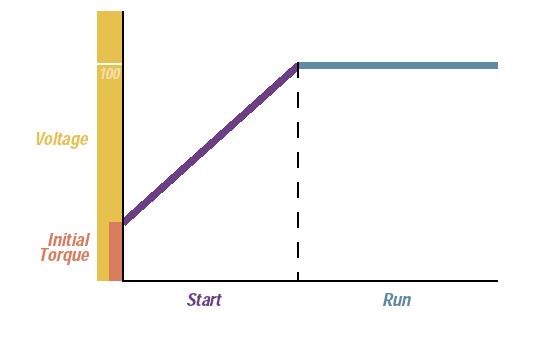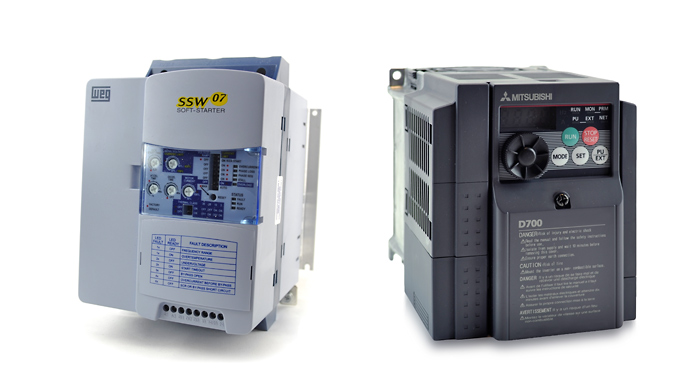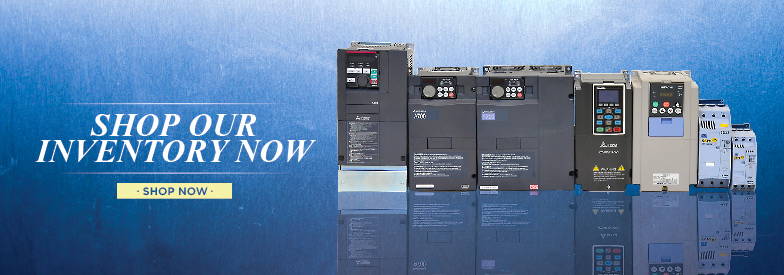Full speed ahead? Not so fast... Soft Starters and VFDs will improve operations and enhance your applications
What is a Soft Starter?
An RVSS (Reduced Voltage Soft Starter) is a solid state switching device first invented by a NASA engineer named Frank Nola. Throughout the years RVSS’s have been marketed as energy savers and are still sometimes referred to as “Nola devices” after their inventor. Today soft starters are not sold for their energy savings, but rather for their ability to reduce starting voltage, currents, and torques. In addition, just as their name suggests—soft starters are equipped to allow the voltage to start at a lower level, gradually letting it rise to full power in a slow smooth method like the graph shows below.

What is a VFD?
As defined in our What is a VFD page, a Variable Frequency Drive (VFD) is a type of motor controller that drives an electric motor by varying the frequency and voltage supplied to the electric motor. One important note to remember about a VFD is that where a soft starter only controls the voltage at start up, a VFD controls both voltage and frequency at all speeds, allowing full torque to be maintained throughout the process.
Why do I need a RVSS or a VFD?
Now that you have a basic sense of what soft starters and VFDs are, understanding their function is a critical step in deciding why you need one over the other. Soft starters and VFDs can play an important part in utilizing and protecting valuable equipment. One reason is because often when a motor is first turned on, the torque is largely uncontrolled, causing shock to any connected equipment and creating possible damage. That’s where an RVSS or a VFD come in, both can be used to reduce that uncontrollable torque and also decrease the initial inrush currents associated with first powering up equipment.
Advantages of a RVSS
- Torque control
- Extends the life of equipment
- Limits electric current
- Often used to meet utility requirements
- Enhanced features
- Better motor protection
Advantages of a VFD
- Allows full range speed control
- Full control over acceleration and deceleration rates
- Provides full torque at all speeds
- Provides large energy savings on most loads
- Ideal for motors requiring repetitive start-stops
- Programmable for many different types of functions and processes
What is the difference between an RVSS and a VFD?
Depending on their implementation, choosing between the two can be a fairly simple process. Although Soft Starters and VFDs share many of the same qualities, numerous differences are apparent in their operation. The noticeable advantage of choosing a VFD over a Soft Starter is evident in the name of the Soft STARTER itself. Soft Starters only have the ability to reduce the voltage during startup, whereas a VFD has the capability to regulate motor speed not only during startup, but also throughout the running of the whole application.
While an RVSS relies on restricting the voltage allowed to pass through to the motor, a VDF does not block the voltage, instead it changes it. This process gives the VFD the ability to regulate the speed of the motor to the specific load. Since VFDs have control of the motor speed throughout the process, it usually results in significant energy efficiency. One thing to be mindful of if space is an issue—as shown by the side-by-side comparison below—VFDs typically take up much more space than an RVSS. If your current application uses a motor control center, soft starters are often easier to install as they will typically fit right back into the motor control center whereas a VFD may not.

Is it worth the investment?
Throughout this article you have learned what soft starters and VFDs are and also why they play an important role in running many different applications. Now, you have the opportunity to decide whether they are right for you. The benefits gained from purchasing either one of them will often outweigh initial costs since the better system performance and the improved processes gained from an RVSS or VFD can be crucial to running many applications. If cost is a factor, an RVSS will be usually one third the price of a VFD - but you should not let that be your deciding factor. The VFD will contribute significant energy savings later on that a soft starter will not. Determining whether the benefits of having a VFD is crucial to your application (like needing to change speed) is often a good start in deciding whether you should purchase a soft starter—which is initially less of an investment but offers less control over all—or a VFD offering more comprehensive benefits.

